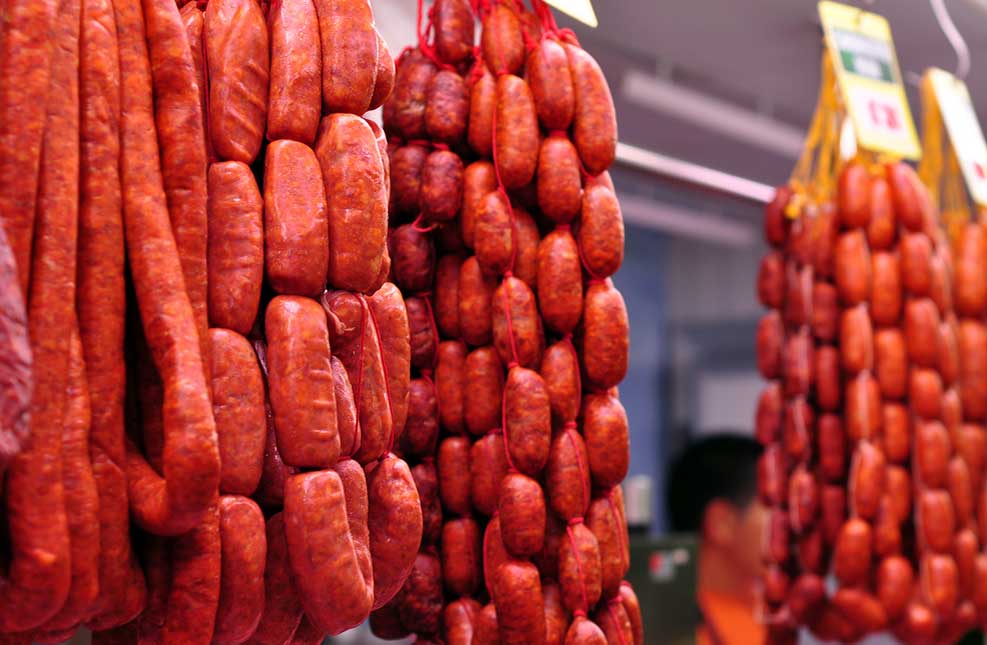
Chorizo
One of the most popular Spanish sausages at international level, although each country has its own tradition when it comes to making chorizo, Spanish chorizos are the most popular, used to eat alone, to prepare stews and much more. For its preparation, pork meat and bacon, paprika, garlic, salt and tradition are needed.
Although its elaboration seems to have no secrets, like any artisan process, tradition has a lot to do with it. And for the moment what we positively know, is that in a good sausage table can not miss a portion of sliced chorizo… everyone will thank you!
What is chorizo?
According to the dictionary of the Royal Spanish Academy, chorizo is a “short piece of meat gut, usually pork, minced and marinated, which cures in smoke”. But this concept is not enough to explain the wonder of Spanish chorizo. So, let’s start by explaining that the main ingredients of any chorizo are pork and bacon, paprika, garlic and salt. Paprika being the key ingredient in the preparation of this magnificent sausage.
Before the arrival of paprika in Europe, the sausages were white or black, if there was any blood among their ingredients. Yet, the arrival of this spice from the Americas changed everything. As for the recipes, as in most traditional dishes, there is no original recipe as they were passed down from generation to generation and each family had its own.
However, the process was the same, just after the slaughter the meat was selected, seasoned and after a short rest were stuffed into the animal’s guts and finally hung in the cellars and let them cure. The chorizo, once cured (air dried or smoked) was kept in containers made of clay until it was consumed.
Nowadays, traditional and artisan production is highly valued, procedures that make it possible to taste high quality products such as Iberico de Bellota products. This type of product is left to marinate for at least 24 hours and then stuffed and cured for 3 months.
Types of chorizo
Although the ingredients are always the same, there are many types of chorizo. In order not to go on too long we are going to talk alone about pork chorizos and classify them according to three main areas: type of meat, processing area and shape.
Depending on the type of meat
- Traditional: Made with non-Iberian white pork meat.
- Iberian: Made with Iberian pork, fed with feed, with a purity of breed of more than 50%.
- Iberico Bellota (Acorn-fed Iberian): Made with Iberian pork with a purity of more than 50% and unlike the previous type of chorizo, pigs destined to produce acorn-fed Iberian chorizo have enjoyed a period of freedom in the pastureland during the montanera, feeding on acorns and wild herbs.
As for the production area
- De León: Smoked and cured in the cold. Its color is dark red with a generally spicy flavor and a characteristic aroma due to the curing process.
- Galician: This type of chorizo is also smoked, but after drying it is preserved in fat or oil. Visually it has strings like the “longaniza” and can be eaten raw, cooked, fried or roasted.
- Extremeño: In Extremadura, apart from the traditional chorizos, a very typical one called Patatera Extremadura is produced, which although it is a black sausage “morcilla ” type, its appearance and flavour clearly resemble chorizo.
- From Pamplona: Chorizo produced in Navarra is undoubtedly one of the most famous and, in addition to the traditional ingredients, beef is used to make it. For this type of chorizo, fat gut is used and its colour is notable for being between red and orange.
- Riojan (from Rioja): The chorizo produced in the area of La Rioja is protected by a PGI. This sausage is usually horseshoe-shaped and its most obvious characteristic is its intense and balanced aroma.
From Salamanca: Just as the Salamanca ham is one of the best known acorn-fed Iberian ham, so is the Salamanca acorn-fed Iberian chorizo. - De Cantimpalos: One of the most famous products of the whole region of Segovia. This sausage is made using fatty pork meat and, in addition to the basic ingredients, may contain oregano.
- From Cantabria: The best known of Cantabria is that of Potes. It is prepared with lean pork, bacon, salt, salt, pepper, paprika, garlic, oregano and thyme and what makes it special is its natural curing and smoking for 25 days.
- Canary Islands: Unlike the rest of the Spanish chorizos, the Canary Islands chorizo is made with soft paste, which makes it a perfect product for spreading.
According to its shape
- Horseshoe: It is a single piece tied with a rope at both ends forming a horseshoe. Also known as a string. The vela chorizo can also be stapled into several portions.
- Vela (Candle): Straight with a narrow caliber and about 40 cm. long. Its main characteristic is the long, narrow shape similar to that of a candle.
- Cular: The term cular is used for several Iberian sausages with a calibre of more than 38 mm. The cylindrical shape of these pieces is usually irregular due to the use of natural casings.
Now that you know so much about this famous sausage, all you have to do is go to the practical part and enjoy the best Enrique Tomás products.

Buy Sliced Iberian Chorizo-Sachet 80 gr

Buy Sliced Bellota Chorizo from Salamanca

Buy Sliced Bellotta Chorizo from Huelva



